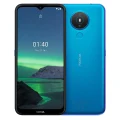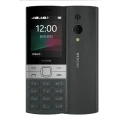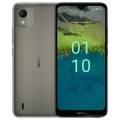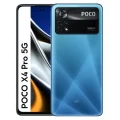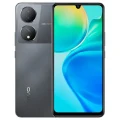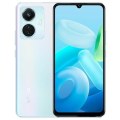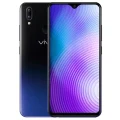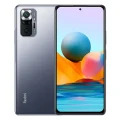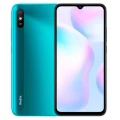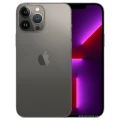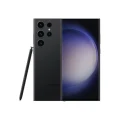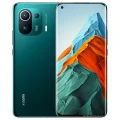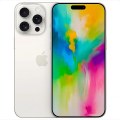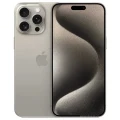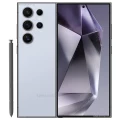Nokia 6
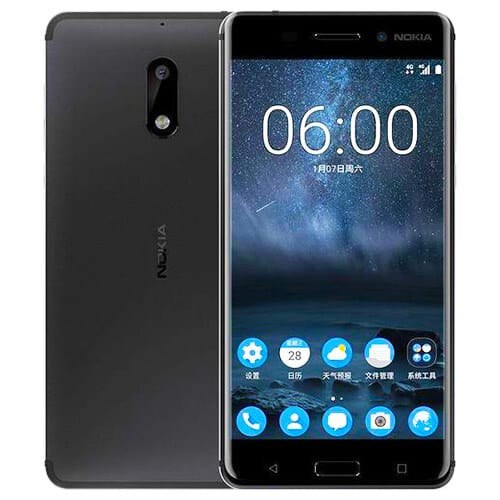


Nokia 6 Price in Bangladesh
The Nokia 6 (3GB+32GB) is priced at BDT 15,500 in Bangladesh. It features a 5.5-inch IPS LCD display with a resolution of 1080 × 1920 pixels. Available in Tempered Blue, Silver, Matte Black, and Copper colors, this 4G smartphone comes with 3GB or 4GB of RAM and 32GB or 64GB of internal storage, expandable via a microSD card.
The device is powered by the Qualcomm MSM8937 Snapdragon 430 processor (1.4 GHz). It has a 16 MP rear camera and an 8 MP front camera with touch focus. The Nokia 6 also includes essential features like an accelerometer and proximity sensor.
Specifications
General
| Model | Nokia 6 |
| Status | Available |
| Official price | 15500 |
Design
| Dimensions | 154 x 75.8 x 7.9 mm (6.06 x 2.98 x 0.31 in) |
| Weight | 169 g (5.96 oz) |
| Colors |
Arte Black, Matte Black, Tempered Blue, Silver, Copper |
Network
| Technology | GSM / HSPA / LTE |
| 2G Network |
GSM 850 / 900 / 1800 / 1900 - SIM 1 & SIM 2 |
| 3G Network |
HSDPA 850 / 900 / 1900 / 2100 |
| 4G Network |
LTE band 1(2100), 3(1800), 5(850), 7(2600), 8(900), 20(800), 28(700), 38(2600), 40(2300) |
| GPRS <strong>GPRS</strong> (General Packet Radio Service) is a packet oriented mobile data service on the 2G and 3G cellular communication system's global system for mobile communications (GSM), Generally, GPRS is used for the purpose of wireless data transfer, such as sharing pictures and videos or browsing the Internet via a mobile phone connection. | |
| EDGE <strong>EDGE</strong> (Enhanced Data GSM Environment) is a wireless network technology generally considered the next step in the 2G network offers data transfer rates up to four times faster than ordinary GSM networks, Generally, EDGE is used for the purpose of wireless data transfer, such as sharing pictures and videos or browsing the Internet via a mobile phone connection. | |
| Speed | HSPA 42.2/5.76 Mbps, LTE Cat4 150/50 Mbps |
Display
| Display Type <strong>Display Technology => </strong> A number of display technologies and types used in mobile phones => TFT (Thin Film Transistor), IPS (In-Place Switching), OLED (Organic Light Emitting Diode), AMOLED (Active-Matrix Organic Light-Emitting Diode), Super AMOLED (an even advanced version of AMOLED), Resistive Touchscreen (Resistive touchscreens contain two layer of conductive material with a very small gap between them which acts as a resistance), Capacitive Touchsceen (Capacitive touchscreen technology consists of a layer of glass coated with a transparent conductor) | IPS LCD capacitive touchscreen, 16M colors |
| Size | 5.5 inches, 82.6 cm2 (~70.7% screen-to-body ratio) |
| Resolution | 1080 x 1920 pixels, 16:9 ratio (~403 ppi density) |
| Features |
Fast battery charging MP4/H.264 player MP3/WAV/eAAC+/FLAC player Photo/video editor Document viewer |
Camera
Main camera
| Camera Setup | Single |
| Primary <strong>Camera</strong> is able to capture photographs and usually videos, The most important characteristics of a camera are the resolution (measured in megapixels), lens focus type (fixed or automatic), higher megapixel cameras are known to capture higher quality photos, but not always a good measurement of the photos quality. |
16 MP, f/2.0, 1.0µm, PDAF |
| Features |
Dual-LED dual-tone flash, panorama, HDR |
| Video | 1080p@30fps |
Selfie camera
| Camera Setup | Single |
| Primary <strong>Camera</strong> is able to capture photographs and usually videos, The most important characteristics of a camera are the resolution (measured in megapixels), lens focus type (fixed or automatic), higher megapixel cameras are known to capture higher quality photos, but not always a good measurement of the photos quality. |
8 MP, f/2.0, 1/4&amp;quot;, 1.12µm, AF |
Hardware
| Chipset <strong>Chipset</strong> is a group of integrated circuits designed to perform one or a more dedicated functions, often with real time computing constraints, Popular smartphones are equipped with more advanced embedded chipsets that can do many different tasks depending on their programming. | Qualcomm MSM8937 Snapdragon 430 (28 nm) |
| CPU <strong>CPU</strong> (Central Processing Unit) mostly known as processors, CPU processes instructions in order to carry out certain functions that make your device operate properly. Processors are often described as the brain of computers, smartphones and tablets, Smartphones and tablets rely on processors to carry out their every task, Processors are an incredibly important factor in selecting any type of computing device, including your smartphone. | Octa-core 1.4 GHz Cortex-A53 |
| GPU <strong>GPU</strong> (Graphics Processing Unit) is a single-chip processor designed to rapidly manipulate and alter memory to accelerate the creation of images in a frame buffer intended for output to a display, This includes things such as lighting effects, object transformations, and 3D motion. | Adreno 505 |
| RAM (Memory) <strong>RAM</strong> (Random Access Memory) is a type of computer memory that can be accessed randomly, any byte of memory can be accessed without touching the preceding bytes that allows information to be stored and accessed quickly from random locations. RAM is the most common type of memory found in computer systems, smartphones, tablets and other electronic devices. | 3/4 GB |
| Internal Storage <strong>Internal Storage</strong> is a data storage space (flash memory) mostly used in smartphones, tablets and other electronic devices where operating system, apps, music, photos, videos, files and other user data Is stored. | 32/64 GB |
| Sensors <strong>Sensors</strong> are electronic components that detects and responds to some type of input from the physical environment. The specific input could be light, heat, motion, moisture, pressure and location, The output is generally a signal that is converted to use in computing systems, a location sensor, such as a GPS receiver is able to detect current location of your electronic device. |
Fingerprint - (front-mounted), accelerometer, gyro, proximity, compass |
Connectivity
| Bluetooth <strong>Bluetooth</strong> is a wireless communications technology for exchanging data between mobile phones, headsets, computers and other network devices over short distances without wires, Bluetooth technology was primarily designed to support simple wireless networking of personal consumer devices. | 4.1, A2DP, LE |
| Infrared <strong>Infrared</strong> connectivity is an old wireless technology used to connect two electronic devices. It uses a beam of infrared light to transmit information and so requires direct line of sight and operates only at close range. | |
| USB | microUSB 2.0, USB On-The-Go |
| GPS <strong>GPS</strong> The Global Positioning System is a satellite-based radio navigation system, GPS permits users to determine their position, velocity and the time 24 hours a day, in all weather, anywhere in the world, In order to locate your position, your device or GPS receiver must have a clear view of the sky. | Yes, with A-GPS, GLONASS |
| NFC <strong>NFC</strong> (Near field communication) is a set of standards for smartphones and similar devices to establish peer-to-peer radio communications with each other by touching them together or bringing them into proximity, usually no more than a few inches. |
Battery
| Battery Type <strong>Battery Type => </strong> Cell phones run on various kinds of batteries depending on the manufacturer, phone size or shape and features. There are basically four types of cell phone batteries => Lithium Polymer, Lithium Ion, Nickel Metal Hydride and Nickel Cadmium. | Non-Removable Li-Po |
| Capacity <strong>Battery Capacity</strong> is a measure (typically in Amp-hr) of the charge stored by the battery, and is determined by the mass of active material contained in the battery. The battery capacity represents the maximum amount of energy that can be extracted from the battery under certain conditions. | 3000 mAh battery |
Nokia 6 Review: A Budget Smartphone with A Premium Touch
Nokia has long been a name synonymous with reliability and innovation. The Nokia 6 continues this legacy as an affordable smartphone packed with impressive features. But does it stand out in a sea of budget smartphones? Whether you’re a tech enthusiast, casual smartphone user, or mobile gamer, this review will provide you with an in-depth look at the Nokia 6, covering its design, performance, and everything in between to help you determine if it’s the right choice for you.
The Revival of Nokia 6
When the Nokia 6 was first released, it marked the company’s comeback in the Android smartphone market. Positioned as a mid-range device, it aims to provide high-end design and reasonable performance at an affordable price point. Its target audience includes budget-conscious users who still demand quality, as well as gamers and social media users looking for a dependable device without breaking the bank.
Let’s break down its features one by one.
Design and Build Quality
One of Nokia 6’s standout features is its design and build, which punches well above its price range. Crafted from a single block of 6000-series aluminum, it feels solid and premium in hand, almost akin to much higher-priced flagship models. The metal back gives it an industrial look, while the matte finish ensures it isn’t a fingerprint magnet.
Available in elegant color choices like Tempered Blue, Silver, Matte Black, and Copper, the Nokia 6 appeals to users who value aesthetics. It weighs 169 grams, striking a good balance between sturdy build and portability. The device also boasts a Corning Gorilla Glass screen, adding a layer of durability against scratches. For its price, the Nokia 6 delivers a surprisingly high-quality build that surpasses many of its competitors.
Display and Audio Experience
The Nokia 6 comes equipped with a 5.5-inch Full HD IPS LCD display with a resolution of 1080 × 1920 pixels. The screen offers vivid colors, decent contrast, and wide viewing angles, making it ideal for watching videos and browsing social media. Although it doesn’t feature AMOLED technology, the display performs admirably at this price point.
For audio, the Nokia 6 packs dual speakers powered by Dolby Atmos technology. Whether you’re streaming a movie, listening to music, or playing games, the audio quality is crisp, loud, and immersive. These dual speakers give it an edge over other budget smartphones that often compromise on sound quality.
Performance for Everyday Use and Gaming
Under the hood, the Nokia 6 runs on the Qualcomm Snapdragon 430 processor clocked at 1.4 GHz, coupled with either 3GB or 4GB of RAM. While the Snapdragon 430 isn’t the most powerful chipset, it provides adequate processing power for daily tasks like web browsing, social media, and video playback.
For casual gamers, the Nokia 6 performs decently, handling games like Clash Royale and Candy Crush smoothly. However, it may struggle with resource-heavy games like PUBG Mobile. Multitasking is respectable for this price range, though you might notice occasional slowdowns when switching between demanding apps.
With storage options of 32GB or 64GB, expandable via microSD, the device ensures you have enough room for your apps, photos, and music library.
Camera Quality That Surprises
The Nokia 6 features a single 16 MP rear camera with an f/2.0 aperture and phase detection autofocus, delivering sharp and vibrant photos under good lighting conditions. The camera does a decent job with color accuracy, though it may struggle with finer details in low-light environments.
On the front, there’s an 8 MP camera for selfies, complete with touch focus functionality. It performs well for social media-ready selfies and video calls. While its camera setup isn’t groundbreaking, it’s still competitive for its price range, holding its own against similar smartphones.
Battery Life and Charging
The Nokia 6 is powered by a 3000mAh battery, which might look modest by today’s standards but holds up well. With light to moderate usage, including browsing, messaging, and light gaming, you can comfortably get a full day out of the battery. Heavy users may find themselves reaching for the charger toward the evening.
Unfortunately, the device lacks modern fast-charging capabilities. Charging the battery from 0 to 100% can take more than 2 hours with the included micro-USB charger, which feels slightly outdated compared to newer devices that feature USB-C and rapid charging.
User Experience and Software
The Nokia 6 runs on a near-stock version of Android, providing a clean, bloat-free user experience. This makes navigation snappy and intuitive, even on its modest hardware. Additionally, Nokia has been consistent in providing timely security updates, which enhances the device’s longevity and reliability.
The absence of additional UI layers or intrusive apps is a great advantage, especially for those who seek simplicity and efficiency.
How Does Nokia 6 Compare to Its Competitors?
Against other smartphones in the same price range (around BDT 15,500), the Nokia 6 brings a well-rounded package. Its premium build quality and dual speakers stand out as highlights, while its competitors like the Redmi Note series or Samsung Galaxy A series may edge ahead in terms of raw performance or fast charging.
While rivals may offer slightly faster processors and larger batteries, the Nokia 6 differentiates itself with its durable design, stock Android experience, and excellent audio-visual capabilities.
Final Verdict: Is the Nokia 6 Worth It?
The Nokia 6 is a strong contender in the budget smartphone market, offering a premium design, solid performance for daily tasks, and a clean software experience. While its slower charging and mid-tier processor might not appeal to power users, this phone is an excellent choice for those who want a stylish, reliable device without spending a fortune.
We’d recommend the Nokia 6 for:
- Users seeking a high-quality-looking phone on a budget.
- Casual content consumers who value screen and audio performance.
- Fans of stock Android who prioritize a clean and hassle-free user interface.
Nokia’s legacy of quality shines through with the Nokia 6, making it a compelling option in its price segment and a testament to the brand’s ability to evolve with the times.
